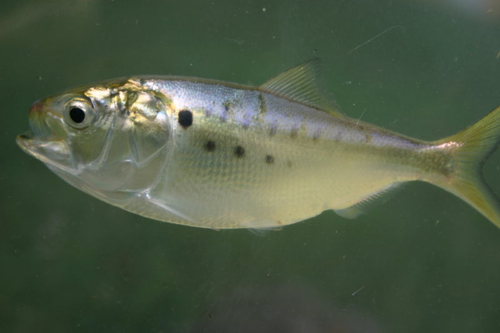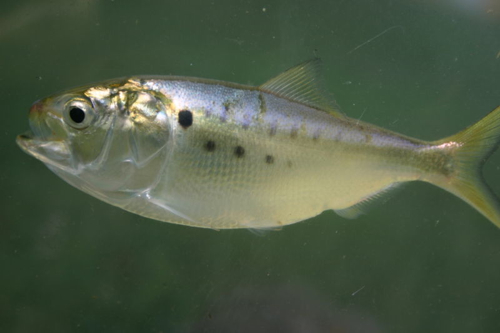 Menhaden, a tiny fish considered “the most important in the sea,” is making big waves off the Atlantic coast.
Menhaden, a tiny fish considered “the most important in the sea,” is making big waves off the Atlantic coast.
The Atlantic States Marine Fisheries Commission (ASMFC), which manages the menhaden, discovered a technical error in how they had been measuring the stocks of the forage fish that showed overfishing had occured in two of the last ten years. In fact, a longer view of the Atlantic menhaden stocks indicated that the small fry had, in fact, been overfished for more than half of the fishing seasons over the last 54 years. (Whoops!)
The ASMFC has been gathering comments through public hearings in preparation for a November meeting in Boston where they could adjust future harvest limits, and ultimately determine the fate of Atlantic menhaden stocks.
Why are menhaden important? They’re filter feeders that swim together in large schools, and it’s believed that each tiny fish can filter phytoplankton from four to six gallons of water per minute. But heavy exploitation of the fishery has meant declining numbers. That’s important when you consider the water quality in areas like the Chesapeake Bay and Long Island Sound, where shrinking numbers of menhaden have coincided with algae blooms, pollution, and dead zones.
Menhaden are also an extraordinarily important link in the food chain. They are feeder fish for larger predatory fish, including sea trout, bluefish, wreckfish, tuna, and most especially, striped bass, whose stocks are suffering from disease (mycobacteriosis) and malnourishment.
So just where have all the menhaden gone?
A whopping 80 percent of the harvest is being taken by Houston-based Omega Protein, which targets the fish for its abundance of oil. Menhaden are literally vacuumed up at sea, ground up and reduced to fish meal and fish oil, much of which is then used in dietary supplements or as feed in aquaculture, dairy cow, and hog operations.
We’re talking about vast quantities of these small, silvery fish. In 2010, the reduction fishery landed 183,085 [PDF] metric tons of menhaden, followed by the commercial bait fishery, which landed 44,000 metric tons.
The majority of the menhaden harvest is taking place in the state waters off Virginia and a small section of North Carolina — the only Atlantic states that haven’t outright banned menhaden fishing by those looking to produce fish oil. But menhaden are also being harvested in federal waters, three to 200 miles offshore, from New Jersey to North Carolina.
That’s why the upcoming the decision by the ASMFC (and the hearings leading up to it) is so important. It’s possible that board members may consider setting new harvest limits designed to preserve a significantly larger portion of the menhaden spawning stock (i.e. wild fish that are left alone to reproduce).
Scientists and advocates have their eyes are on the hearings, as concern over the menhaden population grows. A few days ago, for example, a group of 75 scientists sent a letter [PDF] in support of new measurement tools that ensure more menhaden are kept in coastal waters.
Surprisingly, there are no federal regulations in place for the menhaden fishery. According to Christine Patrick, spokesperson for the National Oceanic and Atmospheric Administration (NOAA), the Atlantic States Marine Fisheries Commission can ask NOAA to protect menhaden in federal waters. But to date, that has not happened.
“They have made these kinds of requests before,” said Patrick in an email to Grist. “For instance … they asked us to close the striped bass fishery in the federal waters, and we did. We are supportive of the commission — and of their process to solicit the input from the public on managing menhaden — and we will be responsive to their request on this issue.”
Toni Kearns, senior fisheries management plan coordinator for ASMFC, says that while the hearings have indeed been civil, much of the finger-pointing is aimed in one specific direction.
“There’s the perception that you have one major harvester [Omega Protein] taking what many consider to be a public resource, and there are some emotional feelings about that,” says Tina Berger, spokesperson for ASMFC. “We’re just trying to manage the stock in a way that keeps it in a healthy position. The tricky part is the reference points we’ve been using to manage them may not have been the best tools.”
According to Berger, the ASMFC had been looking at the number of eggs to determine the health of the menhaden stock, but in reality, that number didn’t always translate to actual fish in the water. In other words, the way the menhaden were being managed wasn’t working. The addendum is looking at raising the amount of fish kept in the water, and their ability them to reproduce.
Alison Fairbrother, director of The Public Trust Project, says, in fact, that the stock has been managed right to its overfishing threshold — a dangerous place to be.
The AFMSC could vote to double the current threshold and increase maximum spawning potential, according Fairbrother. (The threshold is one part of a complex math equation that scientists use to judge the health of a fishery. It’s only one of several measurement tools, including abundance, target rates, growth rate, and mortality.) She adds that “The AFMSC [also] has the option of maintaining the status quo, but it’s unlikely that will happen.”
Ben Landry, spokesman for Omega Protein, says they are cooperating with the ASMFC, but he thinks more measured steps could do the job of increasing the population.
“The numbers being thrown out are like killing a mosquito with a jackhammer. It’s overkill … there’s more than enough to replenish itself,” he told Grist in recent a telephone interview. “There’s no agency, no advocacy group that has more at stake here than Omega Protein.”
Tom Rudolph, policy and research manager for Pew Environmental Group (which has launched an action campaign to organize the public and educate them on the importance of menhaden), disagrees. He says Pew supports conservation figures that are even higher than what the AFMSC have proposed.
Like in most government oversight, change happens slowly when it comes to protecting fisheries. Even if AMFSC adjusts to the amount of menhaden fishermen are allowed to harvest, it’s unlikely those adjustments will be in place before 2013. Additionally, many concerned with the direction of this critical fishery say that what’s at stake is more about the region’s marine ecosystem, and n
ot simply the amounts being hauled ashore.
“For most of menhaden’s history, people have been trying to figure out how to make a buck off of something that was once pretty useless, but very abundant,” says Paul Greenberg, author of Four Fish. “But by restricting quotas on forage fish like menhaden, and trying to value them as much more ecologically expensive, we would hopefully drive the market toward more sustainable [feed] alternatives such as brewery sludge, algae-based feeds, or possibly feeds derived from barley or yeast.”
Note: An earlier version of this article mistakenly attributed Tina Berger’s quote to Toni Kearns.




